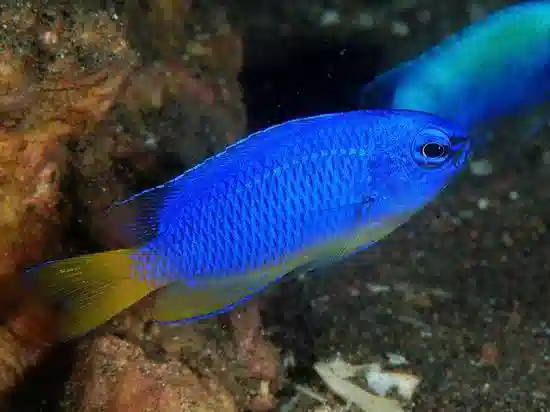The Blue Damselfish, often known as the Blue Devil Damselfish or Chrysiptera cyanea, is a popular marine aquarium fish due to its vibrant coloration and relative ease of care. However, there are some considerations to be aware of when keeping this species. Here’s an overview:
- Appearance:
- As its name suggests, the Blue Damselfish is primarily a bright, electric blue. Males often have a yellow snout and tail, which differentiates them from females.
- Size:
- They are relatively small, typically reaching a size of about 2 to 2.5 inches (5 to 6.3 cm) in length.
- Natural Habitat:
- Blue Damselfish are found in the Western Pacific, ranging from the Great Barrier Reef to the eastern coast of Japan.
- Tank Requirements:
- A tank of at least 30 gallons (around 113 liters) is advisable. These fish are very territorial, so having sufficient space is essential to reduce aggression.
- They appreciate environments with plenty of hiding spots, like live rock formations and corals.
- Diet:
- Omnivorous. In the aquarium, they can be fed a mixture of marine flake food, pellet food, and occasional offerings of meaty foods such as brine shrimp or mysis shrimp.
- Temperament:
- While they are small, Blue Damselfish are known for their feisty and aggressive nature, especially as they mature. They will often establish a territory and defend it vigorously against other fish, even those much larger than themselves.
- Reef Compatibility:
- Generally, they are considered reef-safe, but their territorial behavior might cause stress to more passive tankmates or neighboring corals.
- Care Level:
- Easy in terms of feeding and water parameters. However, their aggression can pose challenges in mixed-species tanks.
- Lifespan:
- With proper care, Blue Damselfish can live for up to 5-6 years in captivity.
- Tankmates:
- Due to their aggressive nature, it’s advisable to house them with other fish that can hold their own. Very passive fish or those with long, flowing fins may be at risk of harassment.
The Blue Damselfish’s beautiful coloration and hardy nature make it an attractive choice for marine aquarists, but its aggressive behavior requires careful planning and consideration when designing a community tank.

